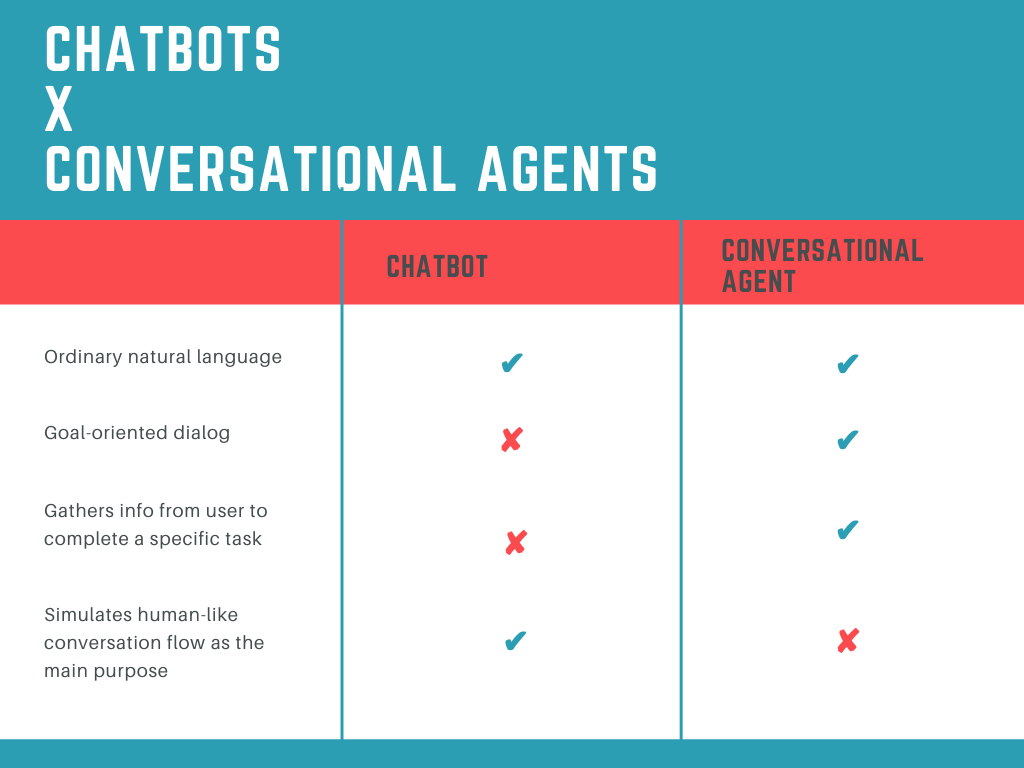Talk chatbot to me
If you’re not in the techie group, you’re most likely not going to be aware that when people talk about chatbots, they are, in most cases, actually talking about what the AI experts call conversational agents or dialog systems.
To get this straight, let’s take a quick side trip down to the history of 'talking' AI systems. The term chatbot, which is quite popular these days, was originally coined in the 1950s, in the context of AI research endeavor that aimed to simulate a human communicator by a computer program. By doing so, the resulting level of communication would be ultimately so authentic that it couldn’t be identified as an artificial system by humans anymore. In accordance with that original meaning of the term, the main purpose of chatbot systems was the computational modeling of human dialog itself. The famous ELIZA chatbot from the 1960s is still one of the most popular references in that regard.
Conversational agents, meanwhile, are a different story. Their aim is to serve as language-based user interfaces for a wide range of specific applications and, therefore, highly relevant for real-world industry applications. For example, virtual assistant systems like Alexa, Google Assistant, or Siri are designed to fulfill a wide variety of tasks by processing voice or text-based user requests such as providing weather forecasts, playing music, or booking flight tickets online. These systems, in general, proceed by collecting the relevant information needed from the user to fulfill the task at hand with a dialog-based user interaction. This pattern of providing automated digital services proved itself to be a powerful tool for a vastly growing number of industry applications.
However, the term “chatbot” became, for some reason, more popular and what the audience chose to adapt to when referring to conversational agents. So, for the sake of it, we’ll also call them chatbots.
Main differences of the terms ‘chatbot’ and ‘conversational agent’ in the Artificial Intelligence field.
"[...] the term 'chatbot' became, for some reason, more popular and what the audience chose to adapt to when referring to conversational agents."
Delivering expert knowledge
Conversational AI is maybe not going to play the main role in your website, but it is, however, certainly going to make a huge difference. Why? Because it’s a great way to interact with your customers and automatically fulfill their requests and demands even with that additional old human touch that you thought only brick-and-mortar shops could have. Businesses — especially those that focus on Guided Selling Solutions — already use conversational AI to offer professional services such as real-time user support, shopping assistance, and expert knowledge-driven solution advice.
When developing AI frameworks for creating conversational agents that show impressive performances — in terms of language sophistication —, as well as the complexity of the topics to deal with, software providers have to overcome hard problems. Controversially, when considering operating a chatbot solution, customers mostly focus on the first part and tend to underestimate the second one. It’s not a good idea to conflate the conceptual representation of the topic with the language processing part.
You should make sure to keep both of them apart. Why? Because it takes a lot of effort to represent topic knowledge on its own. Only in this way will you be able to reuse the topic knowledge independently from the chatbot. This is because chatbots are only one way to fulfill a general pattern that is behind almost every service that is covered by a particular chatbot.
The user specifies their requests and the system comes up with a solution. This applies to a lot of cases, like asking for the weather or describing the demand for a particular product in terms of user requirements and getting a proper recommendation from the service.
There are a lot of possibilities that exist out there to realize this user interaction pattern. Questionnaires done as ordinary forms in websites, illustrated/animated content, or more recent approaches making use of natural language interfaces via text or even voice-based interaction are some of them.
AI-powered conversational agents and virtual assistants dwindle bad customer experience (CX) and prove their users their market worth. Credit: iStockphoto.
To decide which one to use, there a few things to consider. As to briefly mention some of them here, depending on the environment of your shop and on your target group, one can be more suitable than the other. Besides, considering what you want to achieve, as well as how complex your domain is, is paramount when developing such a solution.
In this matter, there is a notable advantage of a chatbot tool driven by a technology that allows you to keep apart the topic representation from the communication interface, like the excentos Workbench does for Guided Selling Solutions by enabling you to use exactly the same concept knowledge and recommendation behavior with different interaction approaches.
The programmed structure of a dialog flow allows the system to assemble all necessary input from the user and deliver smart recommendations. Source: AI-powered chatbot developed by excentos for VAUDE Sport GmbH & Co. KG.
"[...] it’s a great way to interact with your customers and automatically fulfill their requests and demands even with that additional old human touch [...]"
Customers have the urge to feel their value
Not only do customers want to see efficient solutions to overcome the problems they encountered and their inquiries being quickly and effectively resolved, but they also crave human-like interaction. In this sense, customer experience is a key factor and also expected to have as much a great value as the final product itself. Fail to do so and you’ll pay a high price for making a bad impression (and delivering a poor service) on your customers. They will remember for a long time what you didn’t do, and the inconvenience is going to endure for even longer as, thanks to the unlimited number of choices the market offers, your competitors will promptly swoop in and take care of things (that you didn’t manage to).
An average shopping experience was never enough and the great business goals of today are to increase customer satisfaction levels. So why are AI-powered chatbots a remarkably good way to enhance omnichannel experiences? They are there 24/7, therefore available to assist customers during out of hours; they can speak multiple languages; and, as importantly: they provide the opportunity to learn more about your customers, their product preferences and needs. You can additionally use these learnings together with Guided Selling Solutions to improve your domain knowledge and develop your service even further.
Are chatbots to replace human agents?
AI is changing customer experience — for the better — and there’s no arguing that. One consequence is, in the long run, inevitable: the reduction of staff.
Customers need that personal, human touch and the best experience possible when shopping, returning a product or reporting a problem. Now, is it right to assume that the goal is to replace human agents for chatbots? Not necessarily. As the LogMeln 2018 AI Customer Experience Report pointed out, “65% of organizations say that if chatbots could reduce the number of inquiries to their call center, agents would then be trained to handle different or additional tasks”, i.e. not giving the space for chatbots to replace them. This likely means, according to the report, it would provide agents with the opportunity to deal with more complex and strategic tasks and even develop new skill sets.
Chatbots now more than ever
Frankly speaking, there might have never been a more appropriate time to engage in discourse than nowadays. It would come as no surprise if chatbots were to be ranked as one of the best Ecommerce tools to strengthen customer experience during COVID-19.
Apart from medical essentials, the industries of toys, wellness and work from home were some of the ones which reported a sales increase of up to almost 90%. Credit: royalty-free stock.
With the ongoing global pandemic that 2020 brought all of us, together with the social distancing restrictions and most in-stores being closed, customers might feel more than ever the need to engage with you and have human-like representatives to help them in their quests.
"[...] your competitors will promptly swoop in and take care of things (that you didn’t manage to)."
According to the data presented by the Common Thread Collective, only in April, Ecommerce consumer sales increased their revenue by more than 50%, especially in the entertainment and wellness industries. In this sense, regardless of what may come next, we can all agree that AI-powered chatbot solutions for your customers couldn’t ask for a better time to come in.





